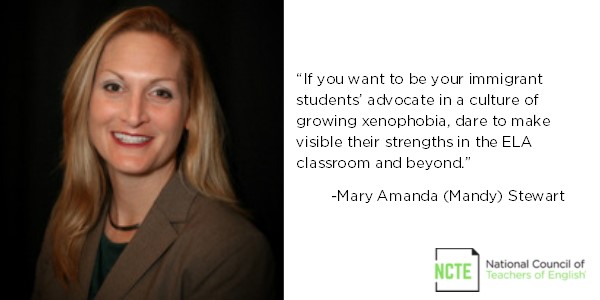This post is written by member Mary Amanda “Mandy” Stewart.
Newcomers represent one of the fastest growing populations in US secondary schools. Coming from other countries, they join us in the ELA classroom with the obvious need to learn English.
English instruction is what they need the most, right?
When I began my career at a newcomer center, that’s exactly what I thought. However, after learning with and from these students for many years, I’ve determined that what they need most is for me to change my view of them. I can become so focused on their need to learn English, and my job to teach it, that I completely overlook their strengths.
How did I change my perspective? I began to understand their lives through their own voices by asking questions, listening, and then listening even more. Now I view the English classroom as an optimal environment where we can name and leverage the many strengths of students learning English for their academic success. I’ve identified five main areas of these hidden strengths that might allow us to be their advocates by seeing them as more than students learning English.

Multiple Languages: Students learning English will already have oral literacy skills in at least one other language. They might also possess reading and writing abilities in their other language(s). Many newcomers engage in language brokering, or translating, for their families, adding to their growing linguistic toolkit. Learn about their multiple language abilities and ask them to use their oral or writing skills in all of their languages for a class project. Choose to see them as multilinguals in all facets of the ELA curriculum.

Desire to Learn & Dream: Sometimes it is a lack of previous opportunity and other times it’s simply a determined spirit, but most newcomers are hungry to learn, particularly English. Yet many of these students do not know how to check books out from their school library. Some assume there is nothing there they can read. Make sure you provide them access to large quantities of engaging and comprehensible literature in English and their first language that they can take home regularly. Ask them about their dreams and help them understand the practical steps they can take to achieve those dreams. You might be surprised by what you hear!

Character: Many of these young people possess remarkable character. In Spanish this can be referred to as educación and manifests itself in the respect they show their teachers, others, and themselves. It is also evident in their work ethic, which extends beyond the classroom. Because their parents are usually working, many of the newcomers I’ve interviewed take care of younger siblings after school, frequently while completing household chores such as cooking dinner. I’m also surprised at how many students maintain part-time and sometimes even full-time jobs. They are eager to earn money to support themselves in the United States and often send some of that money to family in their home countries. We can learn about their lives outside of school, acknowledge their hard work, and look for ways to bring these experiences into our classroom.

Transnationalism: Newcomer students will have lived in at least two countries—sometimes more. They maintain ties to their country in various ways—through actual visits, online social networking, talking to friends via apps, and viewing media from their home country. They regularly cross borders, whether physically, digitally, or culturally, on a daily basis, nurturing skills needed for an interconnected world. Their unique perspectives and international sources of information can greatly enrich your English classes. As you invite their transnational skills into your classroom, it can become a place of global learning for all your students.

Commitment to a Community: The newcomer students I’ve worked with are usually very committed to others in their various communities—fellow newcomers, friends, or family members. I often observe them helping one another in class, and they are eager to offer something to other students, such as world language tutoring. They regularly sacrifice their own free time to contribute to their family unit or to other students in the class. This can lend itself to excellent collaborative groups in the classroom and will work toward fostering a true literacy learning community. This trait will also go a long way in developing newcomers’ roles as productive citizens in their schools, communities, and society.
These are the five primary hidden strengths I’ve seen in the lives of newcomer students. Yes, they need to learn English, and it is our job to facilitate that growth, yet our greatest tool could be acknowledging and leveraging the many notable traits and skills they already possess. If you want to be your immigrant students’ advocate in a culture of growing xenophobia, dare to make visible their strengths in the ELA classroom and beyond.
Mary Amanda (Mandy) Stewart (@drmandystewart) is a faculty member in the Department of Reading at Texas Woman’s University, and her work with newcomers appears in Research in the Teaching of English and English Journal. She loves learning with multilingual/multicultural students and is the author of Understanding Adolescent Immigrants: Moving toward an Extraordinary Discourse for Extraordinary Youth (Lexington Books).

